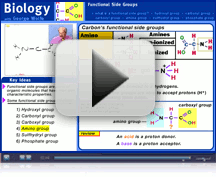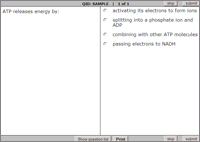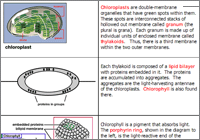Biology compatible with AP*
Emmy Award-winning teacher George Wolfe's excitement for teaching biology is obvious from the first second of the first video. With the best AP Biology teacher taking you step by step through the fundamentals and advanced concepts of biology. You'll be ready to remember everything you'll need for the high-stakes AP Biology exam.
Thinkwell's online AP Biology subscription gives you a comprehensive Biology course through a complete web-based solution that includes all the content you'll need to succeed in AP Biology. Thinkwell works perfectly as a study aid for your school's AP Biology class, and with 24-hour access and one flat price, it's better than a tutor.
Though similar to our college-level Biology course, AP Biology also includes diagnostic assessments geared towards AP exam preparation.
Our complete Biology compatible with AP* package includes:- 12-month Online Subscription to our complete AP Biology course with video lessons, automatically graded AP Biology problems, and much more.
- Printed Notes (optional) are the AP Biology course notes from the Online Subscription printed in a black & white, on-the-go format. These are available for purchase from the AP Biology Course Site.
Printed Notes require the purchase of an online subscription.
(*AP is a registered trademark of the College Board, which was not involved in the production of, and does not endorse, this product.)
Money-Back Guarantee
Biology compatible with AP* Materials
Online Subscription, 12-month access
Access to a complete online package that includes everything you need.
- Thinkwell's video lectures cover the comprehensive scope and sequence of topics covered on the AP Biology exam.
- Diagnostic tests that tell you exactly what you need to study.
- Our automatically graded exercises with immediate feedback allow you to quickly determine which areas you'll need to spend extra time studying.
- Concise, illustrated review notes help you distill the fundamental ideas, concepts, and formulas you'll need to know in order to succeed on the AP Biology exam.
- Subscriptions start when you are ready. Buy now and activate your course anytime you like. Wait up to one year to activate your subscription; your 12-month subscription doesn't begin until you say so!
Biology compatible with AP* Details
Thinkwell's Biology AP includes all of these features to prepare you for the big exam:
- Equivalent to 11th- or 12th-grade AP Biology
- More than 380 video lessons (see sample)
- 1000+ interactive AP Bio problems with immediate feedback allow you to track your progress
(see sample) - AP Biology practice chapter tests for all 14 chapters, as well as a final exam to make sure you're ready for the AP Biology exam (only available in the homeschool version)
- Diagnostic tests that tell you exactly what you need to study
- Printable illustrated notes for each topic
- Closed captioning for all videos
- Glossary of more than 1600 biology terms
- Engaging content to help students advance their knowledge of biology:
- Evolution
- Inorganic and organic chemistry
- Organelles, the cytoskeleton, and other aspects of cell biology
- Molecular genetics and DNA replication
- Biotechnology and the Human Genome Project
- Cell reproduction: mitosis and meiosis
- Mendelian genetics and mutation
- Taxonomy and the evolution of Earth's organisms
- Animal systems such as the skeletal, digestive, and nervous systems
- Plant systems and photosynthesis
- Ecology, biomes, and ecosystems
Table of Contents
(Expand All - Close All)1. Evolution
- 1.1 Unity and Diversity of Life on Earth
- 1.1.1 Properties of Life
- 1.2 Early Perspectives in Science
- 1.2.1 An Introduction to Biology
- 1.2.2 The Nature of Science: The Story of Darwin
- 1.2.3 Early Scientific Thought
- 1.2.4 The Emerging Science of Geology
- 1.3 An Introduction to Evolution
- 1.3.1 Linnaeus, Buffon, and Lamarck
- 1.3.2 Darwin: The Voyage Continues
- 1.3.3 Darwin: More Observations
- 1.4 Evolution: The Theory of Natural Selection
- 1.4.1 Darwin: The Theory of Natural Selection
- 1.4.2 The Theory of Natural Selection
- 1.4.3 Contrasting Lamarck and Darwin
- 1.4.4 Contrasting Lamarck and Darwin, Part II
- 1.5 Fossils and Evolution
- 1.5.1 Fossil Formation, Dating, and Indexing
- 1.5.2 The Fossil Record
- 1.5.3 Some Fossil Surprises
- 1.5.4 The Coevolution of Horses and Plants
- 1.5.5 Mass Extinctions: An Asteroid Can Ruin Your Day
- 1.6 Human Evolution
- 1.6.1 Human Evolution: What Is a Primate?
- 1.6.2 Human Evolution: The Family Tree
- 1.6.3 Human Evolution: The Fossil Record
- 1.7 Evidence for Evolution
- 1.7.1 Evidence for Evolution: Biochemical Similarities
- 1.7.2 Evidence for Evolution: Vestigial Structures
- 1.7.3 Homologous Structures
- 1.8 Species Concepts
- 1.8.1 Species Concepts
- 1.8.2 Speciation
- 1.8.3 Prezygotic Reproductive Isolation
- 1.8.4 Postzygotic Reproductive Isolation
- 1.9 Examples of Artificial and Natural Selection
- 1.9.1 Artificial Selection in Action
- 1.9.2 Natural Selection in Action
- 1.10 The Origin of Life
- 1.10.1 History of Life: The Heterotroph Hypothesis: An Overview
- 1.10.2 The Heterotroph Hypothesis: An Introduction
- 1.10.3 The Origin of Life: Life from Nonlife
- 1.10.4 The Heterotroph Hypothesis: Protobionts
- 1.10.5 The Heterotroph Hypothesis: The First Genetic Material
- 1.10.6 The Origin of Life: The Rest of the Story
- 1.11 Classifying Life
- 1.11.1 The Linnaean System
- 1.11.2 The Linnaean System: Still Changing
2. Inorganic and Organic Chemistry
- 2.1 An Introduction to Atoms
- 2.1.1 Atomic Structure: SPONCH and the Atom
- 2.1.2 Electrons, Orbitals, and Electron Shells
- 2.1.3 Ions, Ionization, and Isotopes
- 2.1.4 Isotopes: Unraveling Photosynthesis
- 2.2 Atoms and Bonding
- 2.2.1 Bonding and Electronegativity
- 2.2.2 Ionic and Covalent Bonds
- 2.2.3 Polar Covalent Bonds, Hydrogen Bonds, and Van der Waals Interactions
- 2.3 Properties of Water
- 2.3.1 Water: Hydrogen Bonding, Solubility, and Specific Heat
- 2.3.2 Water: Adhesion, Cohesion, and a Solid That Floats
- 2.3.3 Water: Hydrophilic and Hydrophobic Substances
- 2.3.4 Dissociation of Water and the pH Scale
- 2.3.5 Hemoglobin as a Buffer
- 2.4 Carbon Chemistry
- 2.4.1 Carbon Chemistry and Isomers
- 2.4.2 Functional Side Groups
- 2.5 Carbohydrates
- 2.5.1 Carbohydrates: Monosaccharides
- 2.5.2 Dehydration Synthesis and Hydrolysis: Disaccharides
- 2.5.3 Polysaccharides: Energy Storage Molecules
- 2.5.4 Polysaccharides: Structural Molecules
- 2.6 Lipids and Nucleic Acids
- 2.6.1 Lipids: An Introduction
- 2.6.2 Saturated vs. Unsaturated Fats
- 2.6.3 Phospholipids, Waxes, and Steroids
- 2.6.4 Nucleic Acids: An Introduction to Genetic Material
- 2.7 Proteins
- 2.7.1 Proteins: Amino Acids and the Peptide Bond
- 2.7.2 Amino Acids: The R Groups
- 2.7.3 Primary and Secondary Structure
- 2.7.4 Tertiary Structure
- 2.7.5 Quaternary Structure
- 2.7.6 Protein Structure: A Summary
- 2.8 Enzymes
- 2.8.1 Bioenergetics: The Laws of Thermodynamics
- 2.8.2 Activation Energy
- 2.8.3 Enzyme Characteristics
- 2.9 Enzyme Action
- 2.9.1 Enzyme Action: The Induced-Fit Model
- 2.9.2 Enzyme Regulation: Allosteric Regulation
- 2.9.3 Feedback Inhibition and Cooperativity
3. Cell Biology
- 3.1 An Introduction to Cell Biology
- 3.1.1 The History of Cytology
- 3.1.2 Prokaryotes vs. Eukaryotes
- 3.1.3 Plant and Animal Cell Overview: The Basics
- 3.1.4 Membranes: Basic Structure
- 3.1.5 The Nuclear Envelope: The Initial Tour
- 3.1.6 Nuclear Function: Who's in Charge?
- 3.2 Membrane-Bound Organelles
- 3.2.1 Cellular Function: Endoplasmic Reticulum
- 3.2.2 Cell Function: Golgi Apparatus
- 3.2.3 Food Vacuole Formation: The Role of the Lysosome
- 3.2.4 Still More Vacuoles and Peroxisomes
- 3.2.5 Mitochondria: Welcome Guests
- 3.2.6 The Origin of Mitochondria and Chloroplasts
- 3.3 The Cytoskeleton
- 3.3.1 The Cytoskeleton: Basic Components
- 3.3.2 Centrioles, Flagella, and Cilia
- 3.3.3 Cell Walls
- 3.4 The Plasma Membrane
- 3.4.1 Plasma Membrane: The Extracellular Matrix
- 3.4.2 The Plasma Membrane: The Fluid-Mosaic Model
- 3.4.3 Proteins as the Mosaic of the Cell Membrane
- 3.4.4 Animal Cell Junctions
- 3.5 Cell Transport
- 3.5.1 Simple and Facilitated Diffusion
- 3.5.2 Passive Transport: Osmosis
- 3.5.3 Active Transport: Ion Pumps and Cotransport
- 3.5.4 Active Transport: The Sodium-Potassium Pump
- 3.5.5 Energy-Requiring Transport: Endocytosis and Exocytosis
- 3.6 Tools for Cell Biology
- 3.6.1 Tools of the Cytologist: Light and Fluorescent Microscopy
- 3.6.2 Scanning and Transmission Electron Microscopes
- 3.6.3 Freeze Fracture and Differential Centrifugation
- 3.7 The Evolution of Metabolic Functions
- 3.7.1 Major Modes of Nutrition Among Organisms
4. Respiration
- 4.1 An Introduction to Respiration
- 4.1.1 ATP Structure and Function
- 4.1.2 Phosphorylated Intermediates
- 4.1.3 Respiration: An Overview
- 4.1.4 Redox: A Brief Review
- 4.1.5 Energy Release from Sugar: A Demo
- 4.1.6 Coenzymes: The Role of NAD+
- 4.2 Glycolysis and Fermentation
- 4.2.1 Glycolysis: The Initial Steps: Energy Input
- 4.2.2 Glycolysis: The Energy Payoff
- 4.2.3 Anaerobic Respiration: The Fermentation of Pyruvate
- 4.3 Aerobic Respiration
- 4.3.1 Aerobic Respiration: The Acetyl CoA Step
- 4.3.2 Aerobic Respiration: The Krebs Cycle
- 4.3.3 Glycolysis and the Krebs Cycle
- 4.4 The Electron Transport Chain and Oxidative Phosphorylation
- 4.4.1 The Electron Transport Chain
- 4.4.2 Oxidative Phosphorylation
- 4.4.3 ATP Yield from Aerobic Respiration
- 4.4.4 Other Fuels in Respiration
- 4.4.5 The Evolution of Glycolysis
5. Photosynthesis
- 5.1 Discovering Photosynthesis
- 5.1.1 The Unraveling of Photosynthesis: A Historical Perspective
- 5.1.2 Photosynthesis: Twentieth-Century Breakthroughs
- 5.1.3 Photosynthesis: The Final Picture
- 5.2 Adaptations for Photosynthesis
- 5.2.1 The Leaf: Adaptations for Photosynthesis
- 5.2.2 The Structure of a Chloroplast
- 5.2.3 Photosynthetic Pigments
- 5.2.4 The Nature of Light
- 5.2.5 Photoexcitation and Electron Transfer
- 5.3 The Light Reactions
- 5.3.1 The Light Reactions: An Introduction
- 5.3.2 Photosystem 1
- 5.3.3 Photosystem 2
- 5.3.4 The Light Reactions: A Summary
- 5.4 The Dark Reactions
- 5.4.1 The Calvin Cycle
- 5.4.2 The Calvin Cycle: RuBP Regeneration
- 5.4.3 A Review of Photosynthesis
- 5.5 Photorespiration
- 5.5.1 Photorespiration
- 5.5.2 C4 Plants and CAM Plants
- 5.5.3 The Evolution of Photosynthesis
6. Molecular Genetics
- 6.1 Discovering DNA
- 6.1.1 Molecular Genetics: The Protein vs. DNA Debate
- 6.1.2 Continuing to Link Genes to Chemicals: Muller, Beadle, and Tatum
- 6.1.3 Griffith and Transformation
- 6.1.4 Avery, MacLeod and McCarty/Hershey and Chase: DNA Wins!
- 6.1.5 Chargaff and Franklin and Wilkins: The DNA Story Begins
- 6.2 DNA Structure Revealed
- 6.2.1 Watson and Crick: The Clues
- 6.2.2 Watson and Crick: The Double Helix
- 6.3 Introduction to DNA Replication
- 6.3.1 Replication: Meselson and Stahl
- 6.3.2 DNA: Polymerization with Triphosphate Nucleotides
- 6.4 Events of DNA Replication
- 6.4.1 Events at the Replication Fork: The Leading Strand
- 6.4.2 Events at the Leading Strand, Part II
- 6.4.3 Events at the Replication Fork: The Lagging Strand
- 6.4.4 Proofreading, End Replication, and Telomeres
- 6.4.5 DNA Replication: A Summary
- 6.5 Transcription
- 6.5.1 Transcription and Translation: An Overview
- 6.5.2 Transcription: RNA Formation from the DNA Template
- 6.5.3 Transcription: Termination and RNA Protection
- 6.5.4 Posttranscriptional Modification/RNA Splicing
- 6.6 Translation
- 6.6.1 Translation: Ribosomal and Transfer RNA
- 6.6.2 The Role of Transfer RNA: Charging a tRNA Molecule
- 6.6.3 Translation: Initiation Events
- 6.6.4 Translation/Elongation: The Initiation of Elongation
- 6.6.5 Elongation Continued and Termination
- 6.7 Protein Synthesis Review
- 6.7.1 Polypeptide Destinations: Signal Peptides and ER Ribosomes
- 6.7.2 Protein Synthesis: An Overview
- 6.8 The lac Operon
- 6.8.1 Control Mechanisms: Lactose Metabolism in E. coli
- 6.8.2 Jacob and Monod's Model: The lac Operon
- 6.8.3 lac Operon: The Summary
- 6.9 Eukaryotic Genomic Organization
- 6.9.1 The Eukaryotic Genome: DNA Packing
- 6.9.2 Eukaryotic Genomic Organization: Repetitive DNA
- 6.9.3 Eukaryotic Genomic Organization: Gene Families
- 6.9.4 Eukaryotic Genomic Organization: Transposons and Amplified Genes
- 6.10 Controlling Protein Synthesis in Eukaryotes
- 6.10.1 Eukaryotic Gene Control: Transcriptional Controls
- 6.10.2 Eukaryotic Control Mechanisms: Posttranscriptional and Posttranslational Controls
- 6.10.3 Prokaryotes vs. Eukaryotes: Protein-Making Machinery
7. Biotechnology
- 7.1 Plasmids and Gene Cloning
- 7.1.1 Biotechnology: Plasmids in Prokaryotes
- 7.1.2 Using a Restriction Enzyme to Create a Vector
- 7.1.3 Biotechnology: Gene Cloning
- 7.1.4 Biotechnology: Detection of Cell Clones
- 7.2 Techniques in Biotechnology
- 7.2.1 Biotechnology: Reverse Transcriptase: A Tool Taken from Viruses
- 7.2.2 Using Reverse Transcriptase to Make cDNA
- 7.2.3 Electrophoresis: Separating DNA
- 7.2.4 Sequencing DNA: The Sanger Method
- 7.3 More Techniques in Biotechnology
- 7.3.1 Restriction Fragment Length Polymorphisms: Genetic Markers
- 7.3.2 Polymerase Chain Reaction: DNA Amplification
- 7.3.3 DNA Fingerprinting
- 7.3.4 Southern Blotting
- 7.3.5 Detecting DNA Homology: A Biotechnology Summary
- 7.4 Human Genome Project
- 7.4.1 The Human Gene Pool
- 7.4.2 The Human Genome Project: Recent Findings
- 7.4.3 The Human Genome Project: Applications
8. Cell Reproduction
- 8.1 An Introduction to the Cell Cycle and Mitosis
- 8.1.1 The Eukaryotic Cell Cycle
- 8.1.2 Mitosis: An Overview
- 8.1.3 Mitosis: The Phases
- 8.1.4 Cytokinesis
- 8.2 Regulating Mitosis
- 8.2.1 Cell-Cycle Regulation: Protein Kinases
- 8.2.2 Cell-Cycle Regulation: Other Mechanisms
- 8.2.3 Cancer: When Mitosis Goes Unchecked
- 8.2.4 The ras Gene and the p53 Gene
- 8.3 Meiosis
- 8.3.1 Sexual Reproduction and the Role of Meiosis
- 8.3.2 Homologous Chromosomes: Thanks, Mom and Dad!
- 8.3.3 Meiosis: Prophase I
- 8.3.4 Disjunction and Meiosis II
- 8.3.5 Mitosis vs. Meiosis
- 8.4 Understanding Meiosis
- 8.4.1 Independent Assortment
- 8.4.2 Spermatogenesis: Meiosis in Males
- 8.4.3 Oogenesis: Meiosis in Females
9. Mendelian Genetics and Mutation
- 9.1 Gregor Mendel
- 9.1.1 Heredity: The Story of Gregor Mendel
- 9.1.2 Mendel's Findings: A First Look at Phenotypic Ratios
- 9.1.3 Mendel's Conclusions: Alternate Alleles and Dominance
- 9.1.4 Mendel's Conclusions: Segregation and Recombination
- 9.2 The Laws of Mendelian Inheritance
- 9.2.1 Determining Heterozygosity: Test Crosses and Back Crosses
- 9.2.2 Mendelian Inheritance
- 9.3 Segregation and Independent Assortment
- 9.3.1 Segregation and Independent Assortment
- 9.3.2 Independent Assortment: An Explanation
- 9.4 Laws of Probability
- 9.4.1 Laws of Probability: Rule of Multiplication
- 9.4.2 The Multiplicative Law: Some Extensions
- 9.4.3 Laws of Probability: The Additive Rule
- 9.4.4 Using the Laws of Probability in Dihybrid Crosses
- 9.5 Genetic Dominance
- 9.5.1 What Is a Dominant Gene? Intermediate Inheritance
- 9.5.2 Codominance and Multiple Alleles: ABO Blood Genes
- 9.5.3 ABO Blood Groups: Inheritance Patterns and Pedigree Charts
- 9.6 Epistasis
- 9.6.1 Epistasis: One Gene Affecting Another
- 9.6.2 The Bombay Phenotype: Infidelity or Epistasis?
- 9.7 Inheritance Patterns
- 9.7.1 Polygenic Inheritance
- 9.7.2 Pleiotropy: Multiple Phenotypic Effects
- 9.7.3 Sickle Cell Anemia: The Case against Dominant and Recessive
- 9.8 Linked Genes and Genetic Mapping
- 9.8.1 Linked Genes
- 9.8.2 Crossing Over and Recombination: A Tool for Mapping Genes
- 9.8.3 Gene Mapping Using Recombination Frequencies
- 9.8.4 Linking Genes to Chromosomes: The Work of Morgan
- 9.8.5 Morgan's Conclusions
- 9.9 Sex Linkage and Pedigree Charts
- 9.9.1 Sex-Linked Traits in Humans
- 9.9.2 X Inactivation in Humans
- 9.9.3 The Use of Pedigree Charts to Determine Possible Genotypes
- 9.9.4 Pedigree Chart: Problem Review
- 9.10 Problems in Heredity
- 9.10.1 Problems in Heredity
- 9.10.2 Problems in Heredity: Chromosomal Aberrations
- 9.10.3 Translocations: 14/21 Downs
- 9.11 Genetic Mutation
- 9.11.1 Genetic Mutation
- 9.11.2 Genetic Mutation: Different Forms of Point Mutations
- 9.11.3 Genetic Mutation: Insertion and Deletion
- 9.11.4 Genetic Screening
10. Population Genetics and Evolution
- 10.1 The Hardy-Weinberg Theory
- 10.1.1 Population Genetics: Darwin Meets Mendel
- 10.1.2 An Introduction to Hardy-Weinberg Theory
- 10.1.3 The Hardy-Weinberg Equation
- 10.1.4 Using the Hardy-Weinberg Theory
- 10.1.5 Using the Hardy-Weinberg Theory II
- 10.1.6 Hardy-Weinberg: What Does This Have to Do with Evolution?
- 10.2 Departing From Hardy-Weinberg Equilibrium
- 10.2.1 Microevolution by Genetic Drift
- 10.2.2 Microevolution: Continued
- 10.3 Variations in Populations and Modes of Selection
- 10.3.1 Variations Within and Between Populations
- 10.3.2 Modes of Selection
- 10.3.3 The Perfect Organism
- 10.4 Speciation
- 10.4.1 Speciation: What Is a Species?
- 10.4.2 Allopatric Speciation
- 10.4.3 Sympatric Speciation
- 10.5 Evolution
- 10.5.1 Time Frame for Evolution: Gradualism vs. Punctuated Equilibrium
11. The Evolution of Life on Earth
- 11.1 Classifying Earth's Organisms
- 11.1.1 Classifying the Products of Evolution: Taxonomy
- 11.1.2 Building a Cladogram
- 11.1.3 Molecular Methods for Classifying Organisms
- 11.1.4 A Phylogenetic Tree of Organisms: A Three-Domain System
- 11.2 Domain Archaea
- 11.2.1 The Archaea
- 11.3 Domain Bacteria
- 11.3.1 The Bacteria
- 11.4 Protists and the Origin of the Eukaryota
- 11.4.1 Protists: Archaezoa and Euglenozoa
- 11.4.2 Protists: Alveolata and Stramenopila
- 11.5 The Colonization of Land by Plants
- 11.5.1 Plant Phylogeny: The Colonization of Land
- 11.5.2 Plant Phylogeny and Alternation of Generations
- 11.6 Alternation of Generations: Mosses, Ferns, and Gymnosperms
- 11.6.1 Alternation of Generations: Mosses
- 11.6.2 Alternation of Generations: Ferns
- 11.6.3 Alternation of Generations: Gymnosperms
- 11.7 Angiosperms
- 11.7.1 Alternation of Generations: The Structure of a Flower
- 11.7.2 Alternation of Generations: Angiosperms
- 11.7.3 Embryogenesis in Angiosperms: Dicots and Monocots
- 11.8 Fungi
- 11.8.1 Introduction to the Fungi
- 11.8.2 Diversity of Fungi
- 11.9 Evolution of the Animal Kingdom
- 11.9.1 Constructing a Phylogenetic Tree of Animals: Animal Development
- 11.9.2 Developmental Data for the Phylogenetic Tree of Animals
- 11.9.3 The Formation of Body Cavities
- 11.9.4 Protostomes and Deuterostomes
- 11.9.5 Animal Diversity: The Cambrian Explosion and the Move to Land
- 11.10 Invertebrates
- 11.10.1 Introduction to Animals: Parazoa and Radiata
- 11.10.2 Animals: Acoelomates, Pseudocoelomates, and Coelomates
- 11.10.3 Diversity of Protostome Species
- 11.11 Deuterostomes
- 11.11.1 Diversity of Deuterostome Species
- 11.11.2 Diversity of Vertebrate Species
- 11.12 Chordate Development
- 11.12.1 Animal Development: A Close-up Look at Fertilization Events
- 11.12.2 Cleavage, Gastrulation, and Organogenesis: A Closer Look
- 11.12.3 Events of Gastrulation and Organogenesis
- 11.13 The Cellular and Molecular Basis of Development
- 11.13.1 Pattern Formation in Drosophila
- 11.13.2 Pattern Formation in Drosophila, continued
- 11.14 Viruses and Prions
- 11.14.1 Viruses and Prions: Living or Nonliving?
12. Animal Systems and Homeostasis
- 12.1 Introduction to Animal Systems and Homeostasis
- 12.1.1 Animal Homeostasis
- 12.1.2 Mechanisms of Homeostasis
- 12.1.3 Animal Tissues: Epithelial Tissue
- 12.1.4 Animal Tissues: Loose Connective Tissue
- 12.1.5 Animal Tissues: Dense, Fluid, and Supportive Connective Tissue
- 12.1.6 Animal Tissue: Muscle and Nerve Tissue
- 12.2 The Skeletal System
- 12.2.1 The Structure of Bone
- 12.3 The Digestive System
- 12.3.1 Introduction to the Digestive System
- 12.3.2 The Beginning of Chemical Digestion
- 12.3.3 Chemical Digestion in the Small Intestine
- 12.3.4 Human Nutrition: Absorption
- 12.3.5 The Fate of Absorbed Nutrients
- 12.3.6 Egestion
- 12.4 Gas Exchange and Transport Systems
- 12.4.1 Introduction to the Gas Exchange of Animals
- 12.4.2 Human Gas Exchange System
- 12.4.3 Human Gas Exchange: The Roles of Respiratory Pigments
- 12.4.4 Carbon Dioxide Transport
- 12.4.5 Structure of the Human Heart
- 12.5 Circulation
- 12.5.1 Maintaining the Human Heartbeat
- 12.5.2 Human Circulation: Blood Vessels
- 12.6 Blood Pressure and Clotting
- 12.6.1 Human Circulation: Blood Pressure
- 12.6.2 Blood Clotting
- 12.7 Human Excretion
- 12.7.1 Human Excretion: Waste Processing
- 12.7.2 Human Excretion: Urinary System Structure
- 12.7.3 The Nephron: Blood Filtration and Urine Production
- 12.8 The Immune System: An Introduction
- 12.8.1 The Immune Response: Nonspecific Defenses
- 12.8.2 The Immune System: Structure and Function
- 12.8.3 Immunity: Clonal Selection Theory
- 12.8.4 Immune Response: An Overview
- 12.8.5 T Cells: Helper T Activation
- 12.8.6 T Cells: Helper and Cytotoxic T Cell Effects
- 12.9 The Immune System Continued
- 12.9.1 B Cells: The Humoral Response
- 12.9.2 Antibodies and DNA Rearrangement
- 12.9.3 Antibody Mechanisms
- 12.10 HIV and the Immune System
- 12.10.1 HIV: An Attack on the Immune System
- 12.11 The Endocrine System
- 12.11.1 Human Regulation: Endocrine Control and Signal-Transduction Pathways
- 12.11.2 The Endocrine System
- 12.11.3 Endocrine Function: Oscillations in Hormone Levels
- 12.12 The Ovarian and Uterine Cycles
- 12.12.1 The Ovarian and Uterine Cycles: Preparation for Pregnancy
- 12.12.2 Hormonal Events during the Female Reproductive Cycle
- 12.13 The Nervous System
- 12.13.1 The Central and Peripheral Nervous Systems and the Neuron
- 12.13.2 Human Regulation: Nervous System: Nerve Function and Reflexes
- 12.14 The Nerve Impulse
- 12.14.1 Human Regulation: The Nerve Impulse: General Events
- 12.14.2 Human Regulation: The Nervous System and the Action Potential
- 12.14.3 Human Regulation: Synaptic Events: Cell-Cell Communication
- 12.14.4 The Nervous System: A Phylogenetic Perspective
- 12.14.5 The Human Brain
- 12.14.6 Processing Centers of the Human Brain
- 12.15 Motor Mechanisms
- 12.15.1 Motor Control: Muscle Microstructure
- 12.15.2 The Neuromuscular Junction: The Contraction Is Triggered
- 12.15.3 The Sliding Filament: Interaction of ATP, Actin, Myosin, and Calcium
- 12.15.4 Muscle Structure and Action
- 12.16 Sensory Reception
- 12.16.1 Sensory Systems: An Introduction
- 12.16.2 Photoreceptors and the Vertebrate Eye
- 12.16.3 The Ear and Equilibrium
- 12.16.4 The Ear and Hearing
13. Plant Systems and Homeostasis
- 13.1 Plant Development
- 13.1.1 Plant Development: Germination
- 13.1.2 Plant Development: Cell Structure and Function
- 13.1.3 Primary Growth: Root Growth and Development
- 13.1.4 Primary Growth: Stem Growth and Development
- 13.1.5 Secondary Growth: Lateral Meristems and Secondary Vascular Tissue
- 13.2 Plant Hormones
- 13.2.1 Regulation in Plants
- 13.2.2 Plant Hormones
- 13.2.3 Signal Transduction Pathways in Plants
- 13.3 Photoperiodism
- 13.3.1 Photoperiodism in Plants: Control of Flowering
- 13.3.2 Phytochromes and the Photoperiodic Response
- 13.4 Plant Transport
- 13.4.1 Transport in Angiosperms: Transpiration
- 13.4.2 The Role of Xylem Tissue and Stomata
- 13.4.3 Plant Transport: Absorption and Lateral Transport in Roots
- 13.4.4 Phloem: The Movement of Sap
14. Ecology
- 14.1 Introduction to Ecology
- 14.1.1 Ecological Organization: The Functional Divisions of the Ecologist
- 14.2 Biomes
- 14.2.1 Land Biomes: An Overview
- 14.2.2 Terrestrial Biomes: Water-Limited Environments
- 14.2.3 Aquatic Biomes
- 14.3 Animal Behavior
- 14.3.1 Ecology at the Level of the Species: Behavior
- 14.3.2 Imprinting and Innate Behavior
- 14.3.3 Nature vs. Nurture: Is There a Genetic Basis for Behaviors?
- 14.4 Competitive and Courtship Behaviors
- 14.4.1 Competitive Behaviors and Survivability
- 14.4.2 Courtship and Mating Behaviors: Survivability
- 14.5 Population Ecology
- 14.5.1 Population Ecology: Populations with Unlimited Resources
- 14.5.2 Population Ecology: The Reality of Limited Resources
- 14.5.3 Population Ecology: Population Strategy: r vs. K
- 14.5.4 Population Ecology: Intraspecific Competition
- 14.6 Community Ecology: Interspecific Interactions
- 14.6.1 Community Ecology: Interspecific Interaction: Predation
- 14.6.2 Interspecific Competition: Ecological Niches
- 14.6.3 Interspecific Associations: Symbiosis
- 14.7 Community Ecology: Succession
- 14.7.1 Community Disturbance: Succession
- 14.7.2 Secondary Succession
- 14.8 Community Ecology: Species Diversity
- 14.8.1 The Decline in Species Diversity and the Current Mass Extinction
- 14.9 Energy Flow in an Ecosystem
- 14.9.1 Ecosystems: A Flow of Energy
- 14.9.2 Ecosystems: Productivity and Energy Flow
- 14.9.3 Productivity Pyramids: Visualizing Energy Flows
- 14.9.4 Productivity Pyramids: Pyramid of Numbers
- 14.10 Chemical Cycling in the Ecosystem
- 14.10.1 Ecosystems and Material Cycles: Water, Carbon, and Sulfur
- 14.10.2 Ecosystems and Material Cycles: Nitrogen and Phosphorus Cycles
- 14.11 Human Effect on the Ecosystem
- 14.11.1 The Effects of Human Population Growth: Lake Eutrophication
- 14.11.2 Toxic Accumulation and Ozone Depletion
About the Author

Sample Video Lessons

Sample Interactive Exercises


